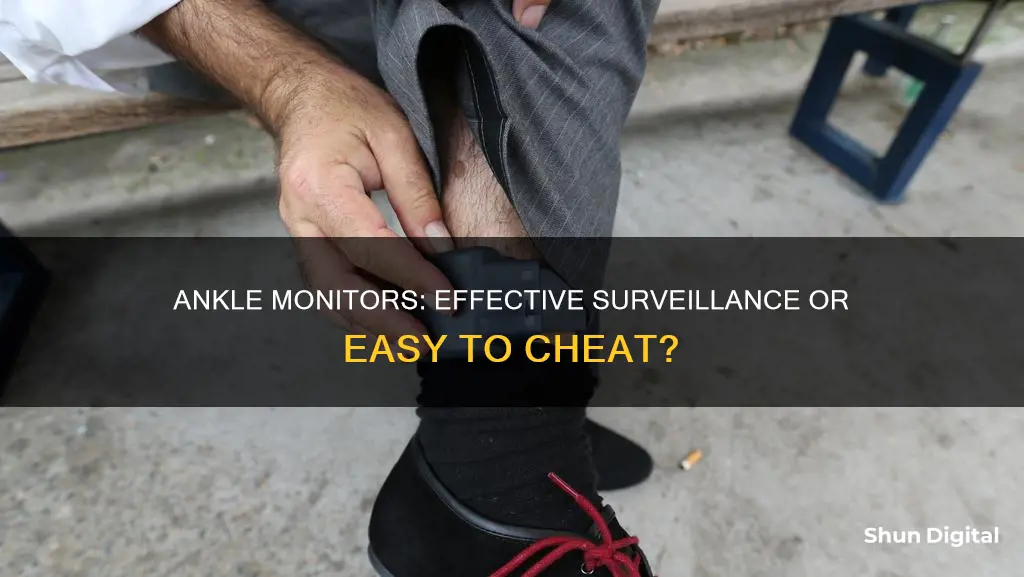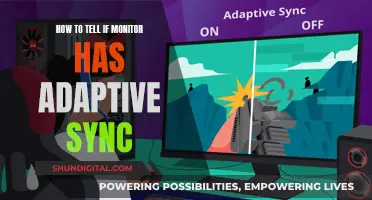
Ankle monitors are often used as an alternative to prison, allowing individuals to serve their sentences while remaining in the community. They are typically used for people on probation or parole, or those awaiting trial. Ankle monitors are also used for people convicted of a crime but considered low-risk. The monitors use GPS technology to track an individual's movements and location, with some also featuring alcohol consumption monitoring. While ankle monitors are less expensive than imprisonment and allow individuals to maintain their jobs, they have been criticised for being uncomfortable, causing skin irritation, and exacerbating issues relating to race, class, and disability.
| Characteristics | Values |
|---|---|
| Purpose | Track individuals under the supervision of the criminal justice system |
| Who wears them? | People on probation or parole, those awaiting trial, or those convicted of a crime but considered low-risk |
| Advantages | Cheaper than imprisonment, allow individuals to maintain jobs and support families, deter repeat behaviour |
| Disadvantages | Can be uncomfortable and cause skin irritation, strict rules that can result in further penalties, expensive fees |
| Effectiveness | Studies show that monitors fail to meet their goals of ensuring court appearance, protecting public safety, and advancing rehabilitation |
| Types | Radio Frequency (RF), Landline Unit or Receiver, Cellular Unit or Receiver, GPS, Voice Recognition (VR), Virtual Monitoring Technology |
What You'll Learn

Ankle monitors as an alternative to prison
Ankle monitors are often used as an alternative to traditional imprisonment, allowing individuals to serve their sentences while remaining in the community. They are typically used for people on probation or parole, those awaiting trial, or those convicted of a crime but considered low-risk. Ankle monitors allow individuals to maintain their jobs and support their families, which can aid in their reintegration into society. Additionally, they are less expensive than incarceration.
However, ankle monitors have been criticised for being inhumane and violating civil rights. They can be uncomfortable and cause skin irritation, and individuals are subject to strict rules and regulations, with any violation resulting in additional penalties or imprisonment. The cost of the monitor is often passed on to the wearer, which can be a significant financial burden, especially for those from low-income backgrounds. This has led to concerns about the monitors exacerbating systemic inequities along lines of race, class, and disability.
Furthermore, there is no evidence that ankle monitors are rehabilitative or reduce recidivism. They can hinder individuals' ability to get their lives back on track by restricting their movements and limiting their access to employment and education opportunities. The data collected by these monitors is also a privacy concern, with law enforcement and private companies having access to individuals' location information.
While ankle monitors may be a preferable alternative to prison for some, they are still a form of incarceration and should not be the only option considered. It is important to address the systemic issues that contribute to high incarceration rates, such as unemployment, poverty, and structural racism, rather than relying solely on surveillance and punishment.
Monitor Buying Guide: May Edition
You may want to see also

Who ankle monitors are for
Ankle monitors are typically used for individuals who are on probation or parole, or those who are awaiting trial. They are also used for people convicted of a crime but deemed low-risk and not a danger to the wider community.
In some cases, ankle monitors are used as an alternative to prison sentences. For example, if a person shows clear signs of substance abuse, a judge may choose an alternative sentence, such as work release or another form of diversion. Ankle monitors can be used in these instances to ensure that a person is adhering to the terms of their sentence with regards to sobriety.
Ankle monitors are also used for those who are awaiting trial. In 2020, during the COVID-19 pandemic, some jurisdictions looked to slow the spread of the disease by seeking alternatives to incarceration, turning to electronic monitoring as a solution.
Ankle monitors are often used for people who are considered high-risk and require constant location monitoring. For example, they are used for sex and violent offenders, as well as for domestic violence cases.
Differentiating Iguanas and Monitors: A Quick Guide
You may want to see also

Advantages of ankle monitors
Ankle monitors have several advantages, especially when compared to traditional imprisonment. Firstly, they are a cost-effective alternative to incarceration, as they are less expensive than keeping an individual in jail or prison. This cost saving is twofold, as those wearing ankle monitors are often required to pay for them, reducing the financial burden on the state.
Ankle monitors allow individuals to remain in the community, maintain their jobs, and support their families. This can aid in their rehabilitation and make it easier for them to reintegrate into society once their sentence is complete.
Ankle monitors are also useful for monitoring substance abuse issues. For example, a Secure Continuous Remote Alcohol Monitor (SCRAM) bracelet can detect alcohol in a person's sweat, alerting authorities if the wearer violates the terms of their release by drinking. This technology can help address addiction issues and reduce recidivism by providing a way to enforce sobriety requirements without the need for prison sentences.
In addition, ankle monitors with GPS technology can be used to track the location of individuals in real time, ensuring they adhere to mobility restrictions such as curfews or designated area limitations. This can be particularly useful for individuals on probation or parole, or those awaiting trial.
Unlocking ASUS Monitor: Stuck at 60FPS, Why?
You may want to see also

Disadvantages of ankle monitors
Ankle monitors have been described as a "digital shackle" that deprives people of their liberties. They are often uncomfortable to wear, causing skin irritation and even panic attacks. The wearer must also find a power outlet and wait for hours every day while the battery recharges. This can be difficult and stressful, as if there is a power outage or the battery dies, the wearer may be sent back to jail.
The cost of the monitor is another disadvantage, with fees ranging from $3 to $35 a day, plus initial setup charges of up to $200. This can be unaffordable, especially for people from impoverished and socially marginalised communities, and can lead to homelessness, as in the case of 60-year-old Willard Birts, who was paying $30 per day for his ankle monitor. In addition, private companies that provide tracking services have been accused of extorting money from people, threatening them with jail if they cannot pay.
Ankle monitors can also restrict the wearer's movement and limit their ability to work, attend school, or care for their families. This can lead to social isolation and stress, exacerbating mental health issues such as depression and anxiety. The stigma associated with wearing an ankle monitor can also be humiliating and stigmatising, with people being judged by others.
Furthermore, ankle monitors may not be effective in preventing crimes or ensuring public safety. For example, in Colorado, a parolee cut off his ankle monitor before committing two murders. In another case, it took 18 years for agents to discover that a sex offender wearing an ankle monitor had been keeping a child captive and repeatedly raping her.
Ways to Check if Your Monitor Boasts 120Hz Refresh Rate
You may want to see also

Ankle monitor technology
Ankle monitors are typically used for individuals who are on probation or parole, or those awaiting trial. They are also used for people convicted of a crime but deemed low-risk and not a danger to the community. Ankle monitor technology has been incredibly useful in alternative sentencing as it helps deter repeat behaviour.
Ankle monitors are worn around the lower leg and use GPS technology to track an individual's movements and location. They are waterproof and fairly lightweight, but they are not permitted through airport security. The monitors are equipped with long-lasting batteries, with SCRAM GPS offering up to 40 hours of power. They are also slim, shock-resistant, and waterproof, with a 30-second tool-free installation.
Radio Frequency (RF) technology is the most effective monitoring method to verify an individual's presence at a residence during specified hours. RF monitors ensure the wearer remains within a specified range and are often used for house arrest. GPS technology, on the other hand, is useful when enhanced supervision is required, such as when monitoring the whereabouts of a sex or violent offender. GPS satellites, cellular towers, and/or Wi-Fi are used to detect the participant's location.
In addition to tracking location, ankle monitors can also be used to monitor alcohol consumption. The Secure Continuous Remote Alcohol Monitor (SCRAM) bracelet, for example, can detect alcohol in a person's sweat, alerting authorities if the person violates the terms of their release by drinking.
Dealing with Multiple Monitors: A Size Guide
You may want to see also
Frequently asked questions
Ankle monitors are devices worn around the ankle that track an individual's movements and location using GPS technology. They are often used as an alternative to traditional imprisonment, allowing individuals to serve their sentences while remaining in the community.
Ankle monitors are typically used for individuals who are on probation or parole, or for those who are awaiting trial. They can also be used for individuals convicted of a crime but are considered low-risk and not a danger to the community.
Ankle monitors use GPS technology to track an individual's location in real time. This allows probation or parole officers to verify that individuals are adhering to their mobility restrictions. Some ankle monitors also include features like alcohol monitoring to detect and report the consumption of alcohol by the wearer.







